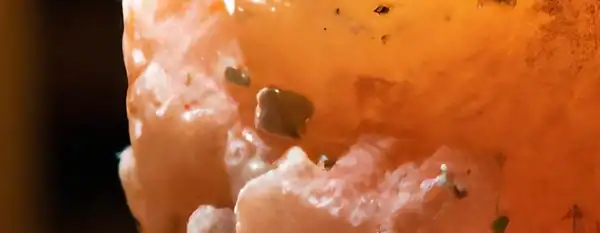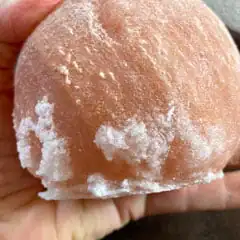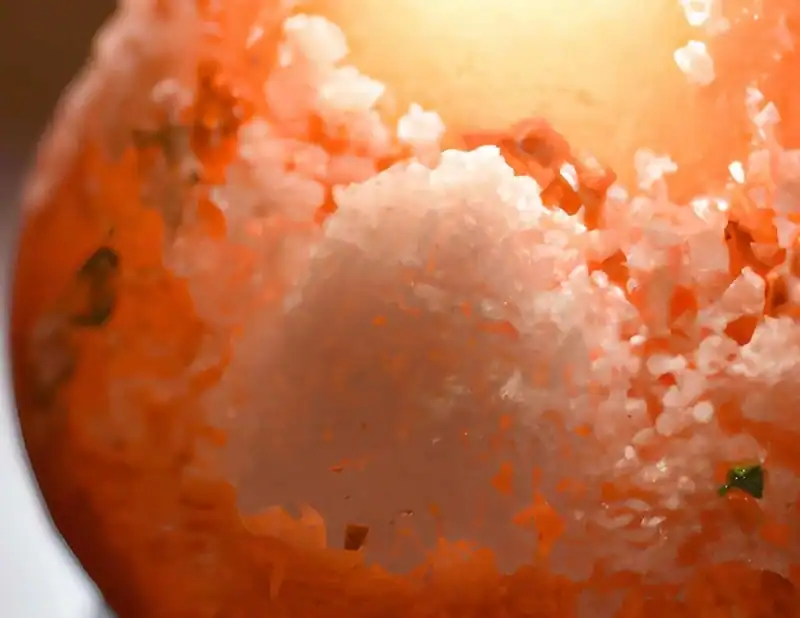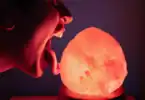Himalayan salt lamps are beloved for their soothing light and supposed air-purifying properties. But many people who own these lamps may have noticed that over time, the salt crystals can become discolored, dirty or even look a bit ‘moldy’. It can be surprising to see this on something that is supposed to purify the air.
However, it is important to understand that the dirt and dark spots on a salt lamp are not a sign that the lamp is not working properly, but rather a result of natural factors and the proper care of the lamp.
In this article, I’ll explore the surprising truth about dirt and surface changes on Himalayan salt lamps, the causes, and most importantly, how to properly maintain and clean them to ensure they continue to function and look their best.

How Himalayan Salt Lamps Work
When the lamp is turned on, with a lightbulb placed inside, the heat from the bulb causes the salt crystals to begin to release trace amounts of water vapor. This water vapor then rises and begins to interact with the surrounding air.
As the water vapor rises, it attracts and can neutralizes positively charged ions in the air, such as dust, pollen, and other allergens. This process is believed to create negatively charged ions. These negative ions are thought to neutralize the positively charged ions in the air, improving the overall air quality. The negative ions also bind to the positively charged ions, causing the particles to become heavy and fall with gravity instead of being inhaled.
Since this happens most in vicinity of the lamp, some of that dust and particles fall directly on the lamp. Over time, these deposits can build up and cause the salt crystals to appear dirty, dull, or discolored.

Another thing that happens as a result of the cycles of heat and humidity is that the salt crystals will recrystallize in a less dense pattern, causing a white frothy or fuzzy looking area on the salt surface.
Some people interpret this as a dirty look, because they prefer the smoother pink to orange color of the salt. Other folks think their salt lamp is melting, but this really is just the natural behavior of salt when exposed to varying levels of humidity and warmth.
For more about the idea that salt lamps can ‘melt’, see our article: Fact Or Fiction: Do Himalayan Salt Lamps Really Melt?
What Causes A Himalayan Salt Lamp To Look Dirty?
Many things can contribute to a Himalayan salt lamp appearing dirty or discolored. Some of the most common causes include:
- Type Of Light Bulb Used – The kind of light bulb used in a Himalayan salt lamp can significantly impact the appearance of the salt crystals. Incandescent bulbs, for example, produce more heat than other bulbs and can cause more water vapor to rise, leading to more recrystallization of the salt crystals. On the other hand, LED or CFL bulbs produce less heat and may result less recrystallization of the salt crystals, but also the potential for less ion exchange.
- Humidity In The Room – The humidity level in the room where the Himalayan salt lamp is located can also impact the salt crystals’ appearance. If the humidity level is high or varies a lot, it can cause more salt recrystallization.
- Amount Of Time The Lamp Is Left On – The longer a Himalayan salt lamp is left on, the more heat is available to power the salt crystals to release water, and then to reabsorb it after the lamp is allowed to cool down.
- Quality Of The Salt – Not all Himalayan salt crystals are the same. They can have different impurities and color variations. Some lamps are made of lower-quality salt crystals that can quickly appear dirty or discolored. The darker areas can be areas of other kinds of minerals – and when combined with salt can also recrystallize and grown denser. For more about the minerals present in Himalayan salt, see: Minerals In Himalayan Salt: Let’s See What’s in There.
- Placement – If the lamp is placed in an area exposed to direct sunlight or other heat sources, this can act as a heat source to power the recrystallization cycle.
It’s worth noting that while the lamp can appear dirty, it’s not necessarily an indication of poor air quality or the light not working effectively.

How To Clean A Himalayan Salt Lamp
Cleaning a Himalayan salt lamp is relatively simple, but avoiding damaging it or injuring oneself is essential. Here are some step-by-step instructions on how to safely clean the salt crystals on a Himalayan salt lamp:
- Unplug The Lamp – Before cleaning the salt crystals, unplug the lamp to avoid any risk of electric shock.
- Clean With A Dry Cloth – Using a dry, soft cloth, gently wipe the salt block to brush off any loose dirt, debris and salt crystals on the surface. You can also use a small brush to remove dirt from crevices and to loosen the white surface salt.
- Use A Damp Cloth – If the dry cloth and brushing are not enough, you can then use a slightly damp cloth to wipe salt block surface. Ensure to keep the lamp’s cord, bulb, or base dry. Use a clean and soft cloth and avoid harsh cleaning agents or abrasives that could scratch or damage the salt crystals.
- Dry The Lamp – Allow the lamp to dry thoroughly before plugging it back in.
Pro Tip – You want to clean your salt lamp sparingly, as this can cause damage to the salt crystals, which can ultimately lead to a shorter lifespan for the lamp. Proper maintenance, such as placing the lamp in a room with moderate humidity and away from direct sunlight and using appropriate bulbs, can help prolong the life of the lamp.
NOTE: Do not try to clean dirt on Himalayan salt lamps using a dishwasher!
Can a Himalayan Salt Lamp Get Mold?
Salt is not a hospitable place for anything to grow. In a wet environment that promotes mold, you are more likely to see it on drywall surfaces or in shower stalls than you would to see it on a salt surface. Extremely dirty lamps that also show salt recrystallization may be mistaken by some people to look like mold.
Can a Himalayan Salt Lamp Leak?
Himalayan salt lamps don’t really leak. The salt is relatively dense and does not easily crumble or flake off. Salt is a desiccant though, meaning that it tends to absorb moisture, mostly from humid air. When you turn on the bulb in your lamp and the salt warms up, some of that moisture can be released and I am guessing that this is what some people interpret as ‘leaking’. A better description might be that the salt is ‘sweating’ – it is releasing some of the moisture it absorbed.
Sometimes this process of absorbing and releasing moisture causes the salt to recrystallize. The recrystallization typically is less dense than the original crystal, and can look fuzzy or frothy as shown in the picture above.
Why Does My Himalayan Salt Lamp Have Dark Spots?
One major thing to remember is that salt is a naturally occurring substance mined from the Earth, so it’s perfectly normal for the grains to have impurities or veins of trapped dirt and debris. That being said, dark spots on a Himalayan salt lamp can be caused by many factors, including:
- Natural Variations In The Salt Crystals – Some Himalayan salt crystals have naturally occurring dark spots or discolorations, which impurities in the salt can cause.
- Exposure To Heat – Exposure to heat can cause the salt crystals to recrystallize. These mineral deposits can appear as dark spots as the salt and the minerals re-deposit on the salt surface.
- Exposure To Light – Exposure to direct sunlight or other light sources can cause the color of the salt block to fade or darken over time.
- Humidity Levels – High humidity can cause the salt crystals to absorb moisture and cause dark spots.
- Air Particles – Salt lamps can absorb dust, pollutants and other impurities from the air to settle on the salt block. Uneven deposits may collect as dark spots.
Final Thoughts
Out of everything I wrote above, the biggest take away is that it’s important to understand that the dirt and recrystallization on a Himalayan salt lamp are not a sign that the lamp is not working properly. These are natural occurrences that happen due to the nature of salt when exposed to light and heat.
But you can do some things to help mitigate dirt from building up on your lamp, including keeping the lamp in a room with moderate humidity levels and avoid exposing it to direct sunlight. When it’s necessary to clean the lamp, wiping down the crystals gently with a damp cloth is enough.







